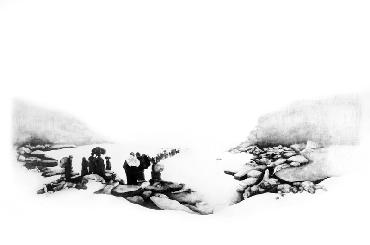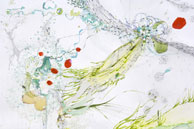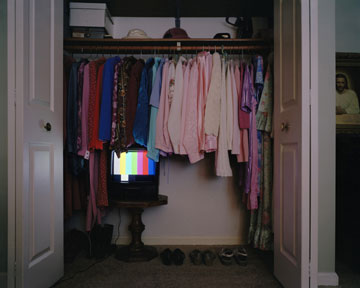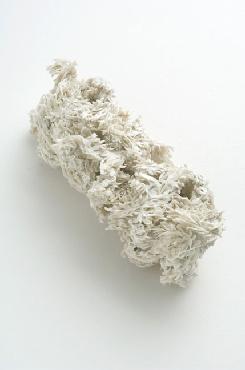Salad Days Sunset: MCAD / Jerome Fellows
Chris Atkins reviews the new crop of Jerome artists at MCAD, and is engaged by what he sees. Be sure to get over to the Minneapolis College of Art and Design Gallery; the show comes down October 29.





Of all the art to be seen this fall in the Twin Cities, make sure that the 2006 Jerome/MCAD Fellows Show, now on at the MCAD Main Gallery, crosses your radar screen. Having spent the past twelve months “emerging,” the Fellows are back with crisp new bodies of work. They are Megan Vossler, Janet Lobberecht, Angela Strassheim, Dan Tesene, and Megan Rye.
Megan Vossler’s Aftermath and Rubble, graphite drawings on massive sheets of paper, are meditations on war and image making. Focusing on the remains of conflict, what is left over and its lingering effects, Vossler doesn’t specify the places where these conflicts happened. The work recalls a multitude of recent military conflicts and refugee populations on the move. In spite of the gravity of these issues, her work is not didactic–a feat, considering how quickly images are weaponized on the media battlefield.
In her smaller framed works, Patrol and Refugees, Vossler draws attention to oppositional notions of movement and space through the absence of a fully rendered landscape. Soldiers patrol land in order to protect and enclose space. For them, territory is to be controlled. Refugees, on the other hand, are forced to move away from their homes and walk through a landscape of displacement with a more uncertain future.
Refusing to hang simply on the wall, Janet Lobberechet’s mixed-media drawings insist on 3-dimensionality without being unruly. It’s Hard to Make the Good Things Last is a tangle of colorful irreconcilables that have been gently collected, rather than cohered. Swirling, spiraling, and gracefully torquing forms on paper, Plexiglass, and wall somehow commingle. There’s an oil-water magnetism that just barely holds it all together without mixing.
Sinuous lines crawl along and over, licking at the paper’s edges and quickly recoiling. Constantly in motion, and never sitting still, Lobberecht’s hand tickles the surface and leaps from paper to the wall and back to paper. There’s an insatiable hunger for space and a thirst for more. It Lingers Then You Forget / Couldn’t Drag Me Away isn’t just a rendering, though; it’s a drawing out. Her fantastic use of repeated lines and obsessively rewritten text is like the working through of an idea; not wanting it too tidy, she leaves it perched at the precipice dividing sketch and shape. Lobberecht’s gestural bio-beaded-scripto-glyphs take off on a graceful tangent that will never be brought back to a center.
Tucked back into a corner of the gallery is Angela Strassheim’s installation, Grandma’s Closet. Taking inspiration from her photograph of the same closet, she has created its exact replica using her grandmother’s clothes and effects; it’s a collection of tangible remnants of a life lived. Standing in front of Grandma’s Closet there’s a whiff of powdery perfume that brings back memories of my grandmother and her favorite Christmas sweater. Smells have an eerie ability to evoke recollections, more strongly than do photographs. Strassheim uses this olfactory dimension, along with the visual and aural, to provide an opportunity to remember as well as to see.
Grandma’s Closet is a kind of memorial but it isn’t filled to the brim with minutiae the way an archive strives to hold someone’s life or a memorial monumentalizes it. It has been reproduced as it may have appeared on any day, like a memory captures and holds onto a strangely familiar scene. In this way, what’s most perilous to Grandma’s Closet as a memorial is its impermanence; we know that it can, and will be, disassembled.
Rapid prototyping is a high-tech form of printing that creates 3-D shapes from digital renderings. A special printer builds shape in layer upon layer of delicate, sandy gypsum. The procedure is very delicately labored but Dan Tesene is a patient and methodical artist. He’s willing to take his time with pushing the potential of the technology, seeing how far it will go in answering his questions on scale and vision.
In False City, he has assembled dozens of miniature buildings to create a rapid prototype cityscape. This is a ‘false city’ by not being modeled on any city in particular, but inaccurate as well because it’s a miniaturized representation. Both form and display seem bound with equal parts intense measurement and creative thinking. There is an attention to the delicate expression of ideas by means of the cold eye of logical observation.
Transit 1-5 are wall mounted map forms that carefully record Tesene’s daily movement over the span of two weeks. Rather than a street-level survey with storefronts and pedestrians, each Transit is a tangle of lines looked down upon from above with an omniscience that conflates space and time. Supposedly, everything is there, right there. But we (and Tesene) know this isn’t true. His use of the cartographic ‘view from nowhere’, that fictional view of every city or road map that looks down from miles above the ground, speaks to the ineffability of establishing and recording his presence in the city.
Megan Rye’s oil paintings situate the viewer as witness but in such a way that we’re not excluded as participants. Riding in the backseat of a Hummer in Falluja to Abu Ghraib, we’re offered the embedded viewpoint of a journalist or soldier who stares through the windshield into a deserted blankness. What you may not know is that this painting began as a photograph taken by Rye’s brother, who was stationed in Iraq with the Marine Corps.
Working from snapshots and newspaper photos for the first time, Rye works through what it means to translate images into oil painting. She has deliberately left something of the original photo in her paintings but how are they different now that she has painted them? Maybe she’s amped up the intensity of each image, but surely there’s room for much more. When brought back as memoirs of the war or as newspaper photos attached to stories, these images spoke with a certain visual language. What happens when they become paintings? It will be interesting to see Rye continue to develop this interest in image reorientation while working through her brother’s massive archive of photos.
Again, make sure to see this strong show of new work at MCAD and treat yourself to some great work by artists who you will soon be seeing at local and national venues. The show runs through October 29.